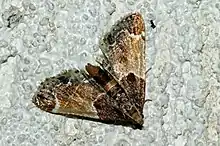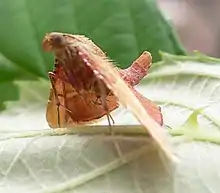Pyralinae
The Pyralinae are the typical subfamily of snout moths (family Pyralidae) and occur essentially worldwide, in some cases aided by involuntary introduction by humans. They are rather rare in the Americas however, and their diversity in the Australian region is also limited. Altogether, this subfamily includes about 900 described species, but new ones continue to be discovered. Like many of their relatives in the superfamily Pyraloidea, the caterpillar larvae of many Pyralinae – and in some cases even the adults – have evolved the ability to use unusual foods for nutrition; a few of these can become harmful to humans as pests of stored goods.[1]
| Pyralinae | |
|---|---|
 | |
| Meal moth (Pyralis farinalis) imago (Pyralini) | |
| Scientific classification | |
| Domain: | Eukaryota |
| Kingdom: | Animalia |
| Phylum: | Arthropoda |
| Class: | Insecta |
| Order: | Lepidoptera |
| Family: | Pyralidae |
| Subfamily: | Pyralinae Latreille, 1809 |
| Type species | |
| Phalaena (Pyralis) farinalis | |
| Tribes | |
|
Endotrichini | |
Description and ecology

This subfamily unites generally mid-sized to smallish moths with a more or less cryptic coloration including most often various hues of brownish colors. Adult females of Pyralinae (except Cardamyla and Embryoglossa) are characterized by the short genital ductus bursae, their corpus bursae barely extending forward beyond abdominal segment 7. Otherwise they are rather nondescript mid-sized moths (large by Pyralidae standards) which at least sometimes can be distinguished from their relatives by possessing forewing vein 7 and having hindwing veins 7 and 8 unjoined as adults.[2]
The meal moth (Pyralis farinalis) and the grease moth (Aglossa pinguinalis) are pests of stored food products, in the case of the grease moth including fats (which are also eaten by the adult moths), and have been inadvertently spread almost worldwide by transport of such goods. Most other species' caterpillars are leaf feeders; the extremely polyphagous larvae of Pyralis manihotalis have been reared from bat guano.[1]
Systematics
The systematics and taxonomy of this subfamily is somewhat provisional. No quantitative phylogenetic analysis had been done as of 2007, though in the mid-late 1990s Michael Shaffer of the London Natural History Museum and Maria Alma Solis of the NMNH prepared the groundwork for further studies by their comprehensive qualitative reviews of Pyralinae morphology. Some cladistic studies of the Pyraloidea do exist however, and these place the Pyralinae among the advanced snout moths, a lineage which otherwise includes the even more autapomorphic subfamilies Epipaschiinae and Phycitinae.[1]
Even though the Pyralinae contain a high number of genera and species, there are a mere three tribes generally accepted nowadays; others that were proposed earlier (in some cases even as independent subfamilies within Pyralidae) are presently treated as junior synonyms of the Pyralini. A large number of genera are considered not to be reliably assignable to one of the three tribes; it is not at all certain that the presently-used subdivisions of the Pyralinae are the last word on the issue.[1]
The tribes – with some significant genera and species also noted – and the genera of unclear affiliation in this subfamily are:[3]
|
Endotrichini Ragonot, 1890 (= Endotrichinae)
|
Hypotiini Chapman, 1902 (= Hypotiinae)
|
|
Genera incertae sedis
- Acteniopsis Amsel, 1959
- Adulis Ragonot, 1891
- Aglossodes Ragonot, 1891
- Antisindris Marion, 1955
- Arctioblepsis C. & R.Felder, 1862
- Benderia Amsel, 1949
- Betsimisaraka Marion, 1955
- Burgeonidea Ghesquière, 1942
- Celetostola Meyrick, 1936
- Comaria Ragonot, 1892
- Cosmethella Munroe & Shaffer, 1980
- Delopterus Janse, 1922
- Diboma Walker, 1863
- Diloxia Hampson, 1896
- Discordia Swinhoe, 1885
- Elaealis Hampson, 1906
- Embryoglossa Warren, 1896
- Epacternis Meyrick, 1933
- Ethelontides Meyrick, 1934
- Euryzonella Ghesquière, 1942
- Eutrichodes Warren, 1891
- Grammiphlebia Hampson, 1906
- Gvelilia Strand, 1920
- Haplosindris Viette, 1953
- Heterocrasa Warren, 1896
- Hirayamaia Marumo, 1917
- Hyboloma Ragonot, 1891
- Hypanchyla Warren, 1891
- Hypsidia Rothschild, 1896
- Imerina Ragonot, 1891
- Lamacha Walker, 1863
- Larice Ragonot, 1892
- Latagognoma Tams, 1935
- Lophocera Kenrick, 1917
- Lorymav Walker, 1859 (Pyralini?)
- Lorymana Strand, 1915
- Lorymodes Hampson, 1917
- Macropyralis Amsel, 1953
- Marionana Viette, 1953
- Maschalandra Meyrick, 1937
- Meca Karsch, 1900
- Megalomia Ragonot, 1891
- Melanalis Hampson, 1906
- Mesosindris Viette, 1967
- Methora Walker, 1866
- Micromystix de Joannis, 1929
- Mimicia Caradja, 1925
- Minooa Yamanaka, 1996
- Mittonia Whalley, 1964
- Namibina Leraut, 2007
- Namibiodes Leraut, 2007
- Neobostra Hampson, 1906
- Nhoabe Viette, 1953
- Nussia Leraut, 2009
- Ocydina Meyrick, 1936
- Omphalobasella Strand, 1915
- Omphalomia Swinhoe, 1894
- Orybina Snellen, 1895
- Parachmidia Hampson, 1896
- Paraglossa Hampson, 1906
- Paraphycita Hampson, 1901
- Perforadix Sein, 1930
- Perula Mabille, 1900
- Peucela Ragonot, 1891
- Phasga Walker, 1863
- Pithyllis Grünberg, 1910
- Poliostola Janse, 1922
- Polycampsis Warren, 1896
- Propachys Walker, 1863
- Proropera Warren, 1896
- Prosaris Meyrick, 1894
- Proteinia Hampson, 1896
- Pseudozitha Leraut, 2007
- Pyralosis Amsel, 1957
- Rhynchetera Hampson, 1896
- Rhynchopygia Hampson, 1896
- Rostripalpus Hampson, 1896
- Rungsina Leraut, 2004
- Sacada Walker, 1862
- Setomigma Ghesquière, 1942
- Scotomera Butler, 1881 (Pyralini?)
- Sindris Boisduval, 1833
- Sphalerosticha Warren, 1897
- Sybrida Walker, 1865
- Tegulifera Saalmüller, 1880 (Pyralini?)
- Toccolosida Walker, 1863
- Trihauchenia Warren, 1892
- Triphassa Hübner, 1818
- Tyndis Ragonot, 1891
- Vitessidia Rothschild & Jordan, 1905
- Xenomilia Warren, 1896
- Zitha Walker, [1866] (including Tamraca; Pyralini?)
The genus Micronix, formerly placed here, seems to belong to the Crambidae, but its exact placement is obscure. For a similar case, see Tanaobela.
Footnotes
- Solis (2007)
- Clarke (1986), Solis (2007)
- See references in Savela (2011)
References
- Clarke, John Frederick Gates (1986): Pyralidae and Microlepidoptera of the Marquesas Archipelago. Smithsonian Contributions to Zoology 416: 1–485. PDF fulltext (214 MB!)
- Savela, Markku (2011): Markku Savela's Lepidoptera and some other life forms: Pyralinae. Version of 2011-MAR-03. Retrieved 2011-MAY-29.
- Solis, M. Alma (2007): Phylogenetic studies and modern classification of the Pyraloidea (Lepidoptera). Revista Colombiana de Entomología 33(1): 1-8 [English with Spanish abstract]. HTML fulltext